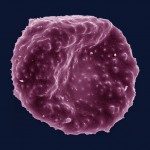Link to Pubmed [PMID] – 7822042
Infect. Immun. 1995 Feb;63(2):693-5
The squirrel monkey, Saimiri sciureus, is an important experimental model for the study of the human malaria parasite Plasmodium falciparum. A detailed karyotype analysis of four different P. falciparum strains propagated in S. sciureus was done using various subtelomeric antigen gene probes. We observed deletion of the complete RESA gene from chromosome 1 in all four strains. Interestingly, a loss of RESA was observed immediately upon adaptation to the squirrel monkey, suggesting that this DNA rearrangement is fundamental for the P. falciparum infection of S. sciureus erythrocytes. However, a RESA-specific gene probe hybridized with chromosome 1 of wild isolates from 28 different patients, indicating that this gene is maintained during infection of humans.

